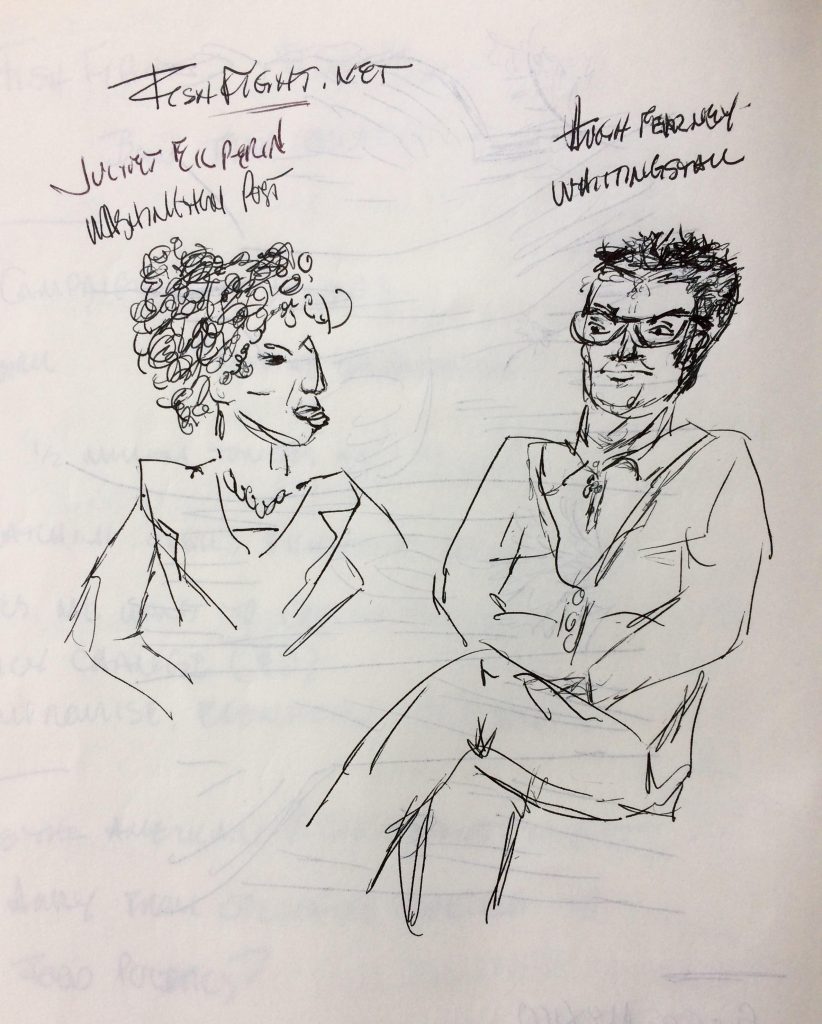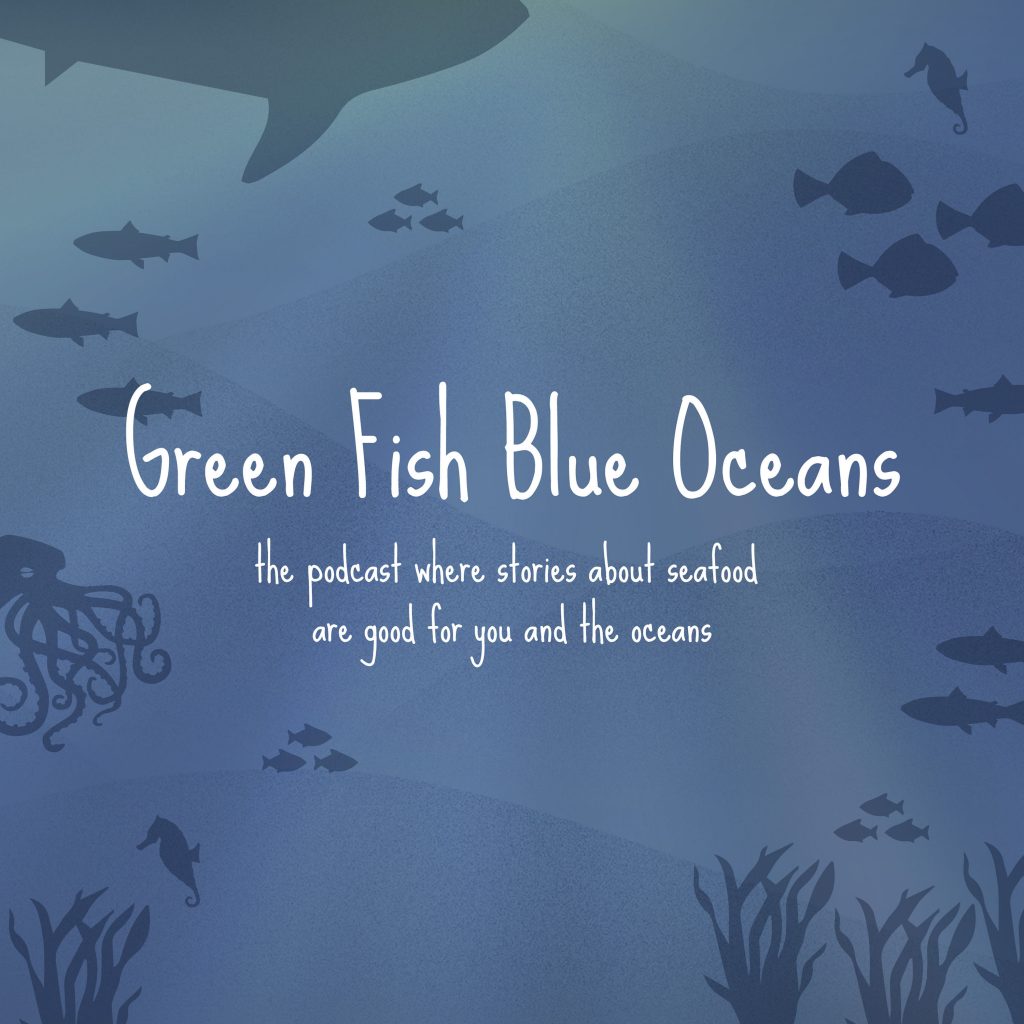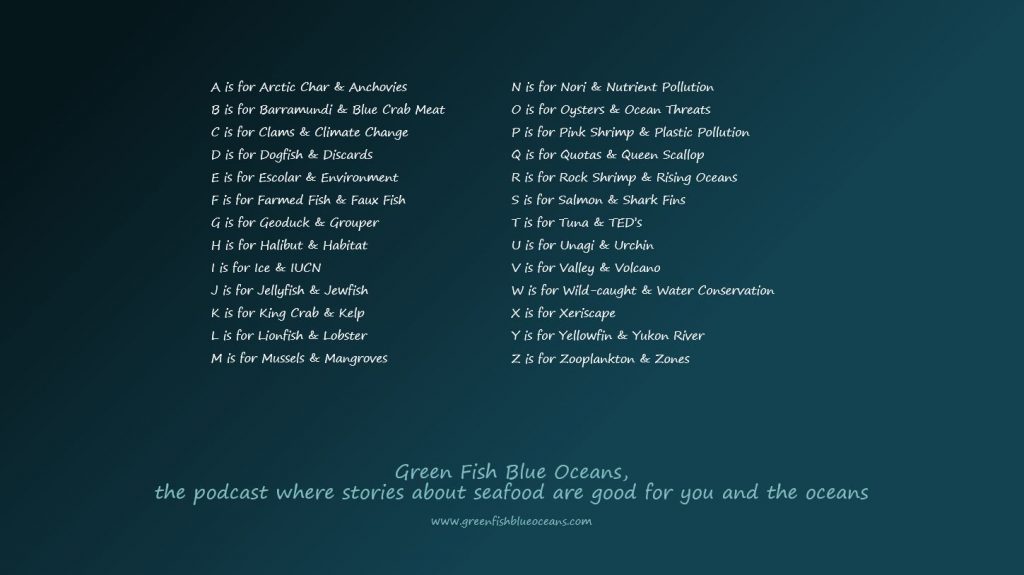Listen here, iTunes or Google Play (And please subscribe!)
Welcome to Green Fish Blue Oceans, the podcast where stories about seafood are good for you and the oceans.
On today’s episode, D is for Dogfish and Discards, I’ll explain all things dogfish and discards in less than fifteen minutes.
What is dogfish? And should you eat it? Where can you find it? What are discards, why should you care and what can you do?
Stick around I’ve got some ‘splaining to do.
D is for Dogfish
Dogfish, like many seafood species, are called by different names. For instance, a dogfish can be called a spiny, piked dogfish, rock salmon, and spiky dog! And again, I don’t know why the seafood industry does this! All said, what you need to know is that a dogfish is a shark.
Here are a few shark stats worth mentioning and then a little backstory about how the dogfish industry came around before I get into whether you should eat dogfish and where you can find it.
- There are over 400 shark species in the oceans. Sharks have been around for hundreds of millions of years.
- They are predatory creatures at the top of the food chain in the oceans, and their presence is necessary for the health of the oceans.
- Sharks are slow to grow and have few offspring, making them a target for overfishing.
- Sharks get caught in fishing gear and are illegally fished for their fins (which I will discuss later in the year in S is for salmon and shark fins). Shark fisheries are not well managed, and without fisheries management, overfishing is also a problem.
- Sadly, many shark species are in decline, and many are severely depleted. Specifically Scalloped, hammerheads, blue, and thresher sharks. I added a Shark chart in the show notes to help you with the what, where, and why of shark declines.
And speaking of overfishing, it could be said that overfishing is the biggest threat to the future of seafood populations.
However, all that said, some species of shark, like the dogfish, are healthy and abundant. They’re a good source of protein and provide jobs for fishermen on the West Coast of the US and the North East coast of the US, specifically for those fishermen who once relied on cod for their livelihood.
What happened to the cod industry? And what does that have to do with Dogfish?
Well, if you’re a seafood nerd, you already know, but if you’re not, then I can sum it up for you with this limerick I concocted while blending a smoothie during research and writing.
There once was a fish named Cod.
Whose life ended
at the tip of a rod.
He gave a good fight,
with all of his might,
but his fate
was a crate
then a plate.
Poor sod.
Cod, a once abundant fish, helped grow the human population of the Western world, according to Mark Kurlansky, the famed commercial fisherman turned journalist and author of Cod.
But after decades of nonstop, ruthless fishing, the once great cod fishery collapsed in 1992, devastating fishing communities and their families worldwide.
Fast forward to 2017.
Enter the dogfish.
Dogfish were once considered discarded fish, which I’ll discuss later in the program. In the late 1990s, dogfish catch levels were low, but by 2010, with good fisheries management, the species rebounded, making dogfish a viable commercial fishing opportunity for ex-NE Cod fishermen.
These sharks are caught on a long line, a sustainable fishing method, and the entire shark is processed and sent abroad. The European market is thrilled to eat dogfish. Now, you can also find dogfish in markets on the West Coast of the US from California to Washington.
At the Market
Remember to ask where your shark was caught. This, along with the fishing method, sets the sustainable shark apart from the nonsustainable shark.
You should be aware that sharks can develop a pissy/ ammonia smell and flavor. Some cooks suggest soaking the shark in milk for a few hours. Personally, if my fish doesn’t smell like the ocean, I pass and look for another species.
Now, I haven’t eaten dogfish, but I did eat shark a few times several years ago when I lived in Florida. More to know what I was selling, not necessarily by choice.
Shark has a mild flavor, and its flesh is meaty. The best cooking methods are on the grill or seared in a skillet.
Shark, like all seafood, cooks quickly, so prepare your salad, your taco station, your wine poured, and the candles lit if that’s how you roll.
While the shark is a good source of protein and low in fat, the shark also contains high mercury levels. So if you’re pregnant or making dinner for the kiddos, do a Nancy Reagan, and “just say no.”
What I love about this species is that it illustrates how the industry can change for the better with proper fisheries management. Once a wild fishery collapses, how do we bring it back?
Since there isn’t an infinite supply of fish in the oceans, fisheries management is part of the solution to ensure the health of the oceans for the future. One drawback of managing fish stocks is that it harms the fishermen. What will they do with their lives while a fish stock is being rebuilt? Fishing communities and fishermen do not rape and pillage the oceans for fun and profit (well some pirates do), but fishing is not only a livelihood, it’s a way of life.
There are hard questions and thoughts here at GFBO. And I don’t have all the answers.
But I do want to share something else that is innovative and cool.
One of the ways we can learn about where fish was caught and when it was caught is by tracking the boats. So how is that done?
You probably guessed, with satellites.
Check out GlobalFishingWatch. You will need to register first, but it is a free service! Click anywhere on the map to see exactly where your fish is being caught in real time.
This incredible opportunity is brought to you by Oceana, Skytruth, and Google. It’s another example of how tech and innovation can help change the fishing industry to create more transparency and slow, illegal, unreported, and unregulated (IUU) fishing.
For decades, the seafood distribution and supply chain was tainted with a lack of transparency. I know firsthand, but I’m not getting into that right now.
My goal at GFBO is to bring you tools so you can make informed choices in the market.
D is for Discards
I’ve got to warn you: what I’m about to say for the next several minutes may make you want to throw up and cuss like a sailor. Maybe both at the same time if that’s possible.
But hopefully, you will hang, listen and then act.
A few years ago, at the MBA SFI, I watched a short film titled Fish Fight that made me want to cry and throw up at the same time. I want to use another “F”, but I won’t—not yet. There will come a day.
In 2010, chef, broadcaster, and advocate Hugh Fearnley-Whittingstall launched a Fish Fight campaign in the UK to change EU fishing policies, specifically the laws related to discards.
At the time, half the fish caught in the North Sea were being thrown back.
That, my friends, is a discard.
Discard is the catch of unmarketable fish, whether by size, species, or not, whether it is not allowed to land because of quota restrictions. I’ll talk more about quota in Q is for Quotas and Queen Scallops later this year.
Now, I was not naïve to the challenges of the fisheries industry.
The industry has long been fraught with challenges on the high seas, the coasts, and on land. But when I saw Hugh’s Fish Fight film, I was appalled. My heart throbbed in my throat. My breathing became shallow. Sweat beads formed along my hairline and under my arms. My stomach churned.
Afterward, all I could do was sketch Hugh being interviewed by author and journalist Juliet Eilperin. I knew that sketch of him would trigger those awful feelings repeatedly so I would never buy the wrong seafood again. Not that I bought the wrong seafood, but this took things to a new level. And to confirm, I don’t feel awful about Hugh; he’s a fascinating, charming character! but the sketch. I also knew I would do something to help other people understand what’s happening in the oceans.
When you’re ready, I included a link in the show notes to the one-minute YouTube video so you can watch it, too. Let me know what you think. Did you react like I did?
So apparently, I had no idea what was happening on the high seas.
Pause. But I’m happy to let you know, Fish Fight campaign was a success. It took two years, but Fish Fight created an agreement to end discard bans and overfishing. The message spread across Europe to Germany, Poland, Spain, and France.
It’s great to see what can happen from large numbers of like-minded people. But really, change happens at the individual level, too. Your choices at the market can impact the future of our fisheries and oceans.
So, how can you help?
- Follow seafood recommendations from Seafood Watch, Environmental Defense Fund, and Marine Conservation Society.
- Speaking of buying sustainable seafood, think about shopping in the freezer aisle at the market.
- Shop online with a trusted source. Who might that be? Ask me. I’m here to help.
- Sign up for this podcast to learn about seafood you might not be familiar with.
- Ask your market to bring in specific sustainable seafood species.
- Make a difference with your cold, hard cash.
- Don’t like what’s happening at the docks or on the ocean? If necessary, contact your politicians at the local, regional, and national levels regarding seafood policies.
- Want to share a good fish story going on in your hood? Got a shark recipe you’d like to share? I’d love to hear from you.
- Hit me up on Facebook, Twitter, or LinkedIn, or shoot me an email at maureencberry@gmail.com.
Don’t just eat seafood. Eat seafood that is good for you and the oceans.
Show Notes & Links
Mark Kurlansky, Cod: A Biography of the Fish that Changed the World
Shark Chart Declines by Species
Environmental Defense Fund/Shark
Dogfish Fishing in Action/YouTube
Safina Center Bycatch/Discards
Follow the Fish Fight timeline
Thanks for listening. (Please subscribe on iTunes or Google Play so you don’t miss an episode.)
Episode 5, E is for Escolar and Environment, is scheduled for March 17, 2017.



